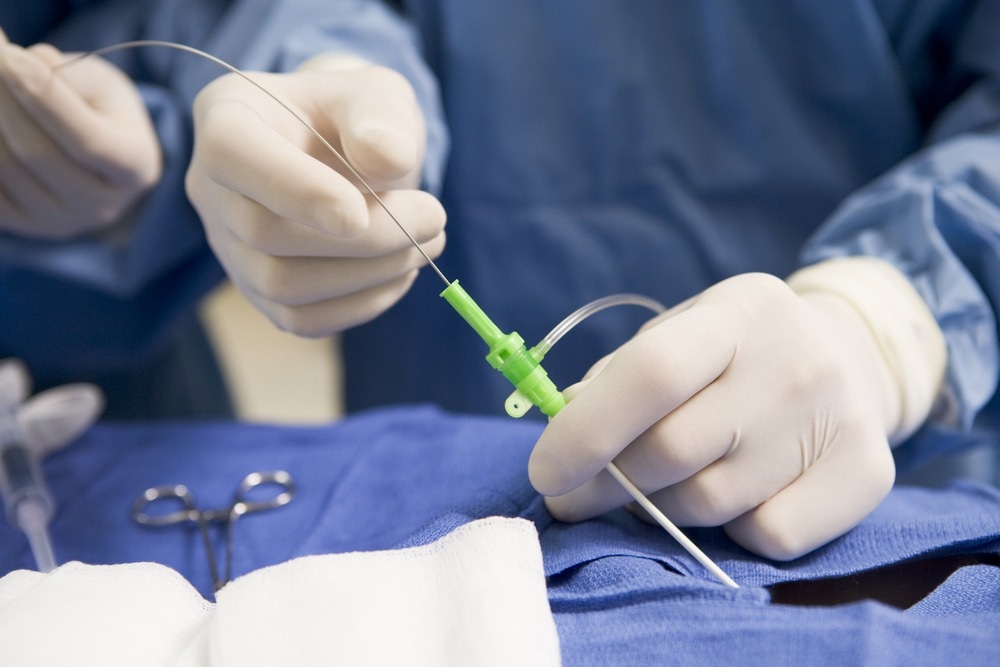Robotic catheters are revolutionizing the landscape of advanced cardiac care by pioneering precision in minimally invasive surgeries. These innovative devices are not only redefining the future of robotic surgery, but also enabling remarkable accuracy in cardiac interventions.

Image Credit: santypan/Shutterstock.com
What is a Robotic Catheter?
The first medical use of robots dates back to 1985, with robotic systems impacting various medical disciplines, including general laparoscopy, orthopedics, and neurosurgery. In cardiac care, these devices are specialized medical robots that assist physicians in performing intricate operations using a catheter, a small and flexible tube.¹
The Sensei X robotic catheter system, which received FDA clearance in 2007, is an example of the evolution of these tools, offering enhanced navigation capabilities during cardiac procedures.² This system has been instrumental in cardiac mapping and ablation procedures, significantly reducing X-ray exposure for both patients and healthcare professionals.²
Recent advances in robotic catheters include shape-shifting designs for navigating complex heart anatomy, enhanced precision through systems like the Sensei X ², and pneumatically controlled soft robotic catheters³ for improved flexibility and control. These innovations promise safer and less invasive cardiac procedures.
Importance of Robotic Catheters in Minimally Invasive Surgery
The market for surgical robots, including robotic catheters, is rapidly growing, with projections indicating a value of $18.4 billion by 2027, reflecting their increasing adoption and importance in healthcare.³
In this context, robotic catheters are revolutionizing minimally invasive surgery by enhancing precision, efficiency, and safety. These advanced tools allow for highly accurate navigation within the body, which is critical for delicate procedures.
Catheters, common medical instruments essential for surgeries involving the cardiac muscle or blood vessels, were the starting point for these devices. They serve several purposes, allowing physicians to diagnose and treat heart conditions by providing a close look at the internal cardiovascular structures. This includes checking for blockages in the arteries, assessing heart valve problems, and identifying causes of symptoms such as chest pain or irregular heartbeat.4
Catheters can also be used to perform specific procedures, such as angioplasty, where it is used to clear a narrowed or blocked artery, or valvuloplasty, where a catheter is used to widen a narrowed heart valve opening. Furthermore, catheters can be used to measure pressure and blood flow in the heart's chambers, take blood samples to measure oxygen levels, and even biopsy a small piece of tissue. Overall, catheters play a crucial role in both the diagnosis and treatment of heart conditions.⁴
However, manual manipulation of catheters can cause harm to both the patient and the medical staff, due to its rate of complications, but the integration of robotic catheters in surgery has been shown to lower risk by 24% compared to traditional surgery.⁴ Additionally, the remote control capabilities of these systems protect surgeons from radiation exposure and potentially infectious pathogens, which is particularly important in the context of pandemics.⁵
Advantages of Robotic Catheters Over Traditional Instruments
X-ray exposure is involved in cardiac catheterization as it helps visualize the heart and its blood vessels, enabling accurate diagnosis and treatment.⁴ During the procedure, a contrast dye is injected through the catheter, and X-rays are taken to look for narrowed or blocked arteries.⁴ This process, known as angiography, allows doctors to see the blood flow in the arteries and the heart.⁴
X-ray fluoroscopy is also used to guide the catheter to the correct location.⁴ However, while the clinical value of these procedures is considered to justify the modest hazard of radiation exposure in the patients, it is important to note that the hazard magnitude is directly related to dose with an unknown threshold, and surgeons are also exposed to harmful X-ray radiation.⁴
To mitigate this, robotic catheter navigation systems have emerged, offering remote control of the catheter and reducing radiation exposure for the health staff.¹ Unlike many surgical robots whose clinical value is still being assessed, these systems have demonstrated a positive impact on clinical outcomes. They augment the procedure's speed and efficiency, decreasing the need for subsequent interventions.¹

Image Credit: Monkey Business Images/Shutterstock.com
Applications of Robotic Catheters in Various Surgical Procedures
Robotic catheters provide innovative surgical solutions for a variety of procedures. They can navigate autonomously within the heart, enabling precise corrections of tissues, making them particularly useful for cardiac blockages or damaged valves.⁶
Additionally, in cases requiring vascular access to the heart, robotic catheters offer a minimally invasive alternative to open-heart surgery, which enhances patient safety and recovery. This precision mitigates the risk of complications in surgeries where exact movements are crucial.⁶
Robotic catheters have been utilized in brain surgery to deliver treatments and perform biopsies, laser ablation, drug delivery, and fluid evacuation with reduced trauma and shorter recovery times. These catheters are minimally invasive and steerable.⁷,⁹
An example of their applications is shown in the study by Wang et al. (2022), where they designed and tested a wireless stent-shaped magnetic soft robot for drug delivery. They were able to actively navigate through the vasculature to release tissue plasminogen activator (tPA) on-demand for thrombolysis.8
The robot was designed to be deployed in the M4 segment of the middle cerebral artery, where it released tPA locally to dissolve blood clots, which is a critical treatment for acute ischemic stroke.⁸
It is important to note that beyond cardiac and brain procedures, robotic catheters are utilized in a variety of other surgical fields, including colorectal, general, gynecology, head and neck, thoracic, and urology surgeries.
Future Developments and Innovations in Robotic Catheter Technology
The future of robotic catheter technology is poised for a revolution in cardiac care, with advancements converging to make heart surgeries safer and less invasive. Shape-shifting robotic catheters, equipped with flexible, air pressure-operated tips and deployable stabilization mechanisms, are set to play a key role.
Integrating artificial intelligence and machine learning will also enhance precision and control during procedures, particularly in complex lesions. As these systems become more accessible, they may expand treatment options for a broader range of patients, further cementing their role in the future of surgical interventions.
References and Further Reading:
Beasley, R. (2012). Medical Robots: Current Systems and Research Directions. Journal of Robotics. [Online] https://doi.org/10.1155/2012/401613
Pneumatically controlled soft robotic catheters offer accuracy, flexibility. (n.d.). Maryland Robotics Center. [Online] https://robotics.umd.edu/news/story/pneumatically-controlled-soft-robotic-catheters-offer-accuracy-flexibility
Surgical Robots Market Revenue Trends and Growth Drivers | MarketsandMarkets. (n.d.). MarketsandMarkets. [Online] https://www.marketsandmarkets.com/Market-Reports/surgical-robots-market-256618532.html
Cardiac Catheterization. (2021). Johns Hopkins Medicine. [Online] https://www.hopkinsmedicine.org/health/treatment-tests-and-therapies/cardiac-catheterization
Zemmar A, et al.(2020). The rise of robots in surgical environments during COVID-19. Nature Machine Intelligence, 2(10), 566–572. https://doi.org/10.1038/s42256-020-00238-2
Rogatinsky J, et al.(2023). A multifunctional soft robot for cardiac interventions. Science Advances, 9(43). https://doi.org/10.1126/sciadv.adi5559
Robotic thread is designed to slip through the brain’s blood vessels. (2019). MIT News | Massachusetts Institute of Technology. [Online] https://news.mit.edu/2019/robot-brain-blood-vessels-0828
Wang T, et al. (2022). Adaptive wireless millirobotic locomotion into distal vasculature. Nature Communications, 13(1). https://doi.org/10.1038/s41467-022-32059-9
Ultrathin needle can deliver drugs directly to the brain. (2018). MIT News | Massachusetts Institute of Technology. [Online] https://news.mit.edu/2018/ultrathin-needle-can-deliver-drugs-directly-brain-0124
Disclaimer: The views expressed here are those of the author expressed in their private capacity and do not necessarily represent the views of AZoM.com Limited T/A AZoNetwork the owner and operator of this website. This disclaimer forms part of the Terms and conditions of use of this website.